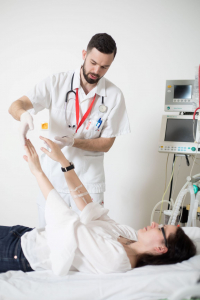Online broadcast will revive Stroke Day
On Saturday, May 15, we commemorate the Day of the Fight against Stroke. St. Anne’s University Hospital Brno, together with the Sarema Rehabilitation Center, prepared a live broadcast on the topic on her Facebook page. Stroke is the second most common cause of death in the world. Every fourth person is at risk and affects patients regardless of age. There are no exceptional cases where the stroke affected the mother during childbirth, the patient with COVID-19 or the driver while driving. It is important to get to the hospital as soon as possible and start intensive rehabilitation as soon as possible after treatment.
Head of the Stroke research team of the The International Clinical Research Center of St. Anne’s University Hospital Brno and professor of neurology Robert Mikulík emphasizes that patients should not be transported to the hospital on their own axis. “If the patient travels on his own, he may arrive at the hospital without a stroke center, which provides comprehensive care for patients with cerebrovascular problems. On the contrary, when he dials 155, the rescuers themselves will contact a suitable doctor or medical facility, ”says prof. MUDr. Robert Mikulík, Ph.D., who, in addition to the research center, also works at the 1st Department of Neurology, FNUSA and LF MU.
If stroke treatment is to be effective, it must be started as soon as possible, ideally within 4.5 hours of the onset of symptoms. Time is crucial for a stroke. The sooner the patient enters the hospital, the higher his chances of recovery. Professor Mikulík also draws attention to an interesting phenomenon, namely the direct connection between COVID-19 and the occurrence of stroke. “Although it has already been shown that COVID-19 can cause stroke and the number of patients should increase, we paradoxically recorded about 15% fewer cases in the hospital during the spring of 2020,” he points out that people should not risk serious consequences and during a pandemic seek professional help.
Equally important is the early start of intensive rehabilitation, as explained by Mgr. Tereza Valíková from the Sarema Rehabilitation Center: “The sooner we start, the sooner we will address the brain and neuroplastic processes. When we start later, we often encounter patients who have already developed poor compensatory habits, which are more difficult to break down, ”he says. Thanks to the start of intensive rehabilitation in time, Mrs. Eliška, who suffered a hemorrhagic stroke during childbirth, is also slowly returning to life. “Eliška had a tumor in her head that was not known. Apparently, due to the pressure at birth, there was bleeding from the tumor and a large swelling of the brain. She fell into a coma at night. After midnight, she was taken by ambulance to the hospital and operated there urgently. The tumor was successfully removed, but the swelling of the brain managed to do great damage, “recalls Eliška’s husband, Petr. His wife is now training intensively at the Sarema Rehabilitation Center and is making great progress, which you can follow on the website www.proelisku.cz. However, due to long-term stays in therapies, she cannot see her two sons as often as she would like.
“Complete cure depends on several factors, such as the extent, age and timeliness of care. Therefore, if you suspect a stroke, contact emergency services immediately. The consequences do not have to be any or minimal, ”adds Tereza Valíková.
For more information, on Saturday 15 May at 5 pm, those interested can “tune in” to a webinar called The Story of a Stroke: The Patient’s Journey. They will learn what the first minutes of a patient look like after arriving at the hospital and how to properly rehabilitate the brain. Just join the event at this link , or the Facebook page of FNUSA-ICRC or FNUSA, who will share the broadcast.


